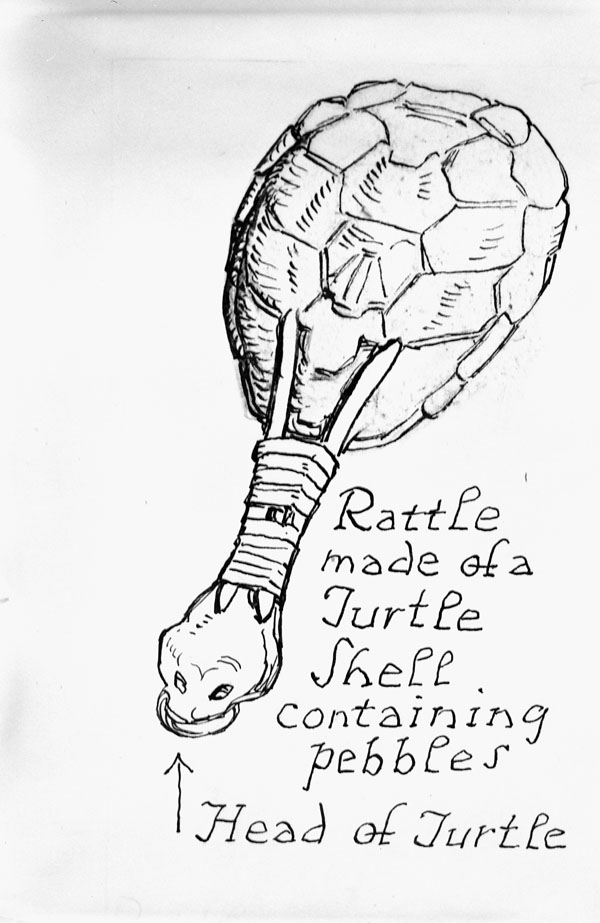And now I come to Canadian music… To start off from
the beginning, the original people – the First Nations as they’re called now –
of course had their own music. It consisted of a lot of chanting, and they also
accompanied it with a variety of instruments. Most of their instruments were
made of materials they found in the wilderness around them, which also varied
based on their location. Gourds, animal horns, and seeds or pebbles were used
to make rattles, which were painted using local plants as dyes and paints.
Wood, animal skins, and shells (in the coastal regions) were also utilized to
make different drums and other instruments. Dances from these various tribes were
performed at pow-wows, in full costumes with music. After Europeans arrived on the continent, these peoples were
discouraged from performing their own music. It’s such a sad repeated story –
I’ve come across this in many of the places the Europeans took control of.
 |
| Yeah, the head of the turtle on the end is a little on the creepy side. My husband would probably like it. |
The French and the British were responsible for
bringing instruments that were popular in Europe – like the violin, guitars,
transverse flutes (ones that are played to the side, like we’re most familiar
with today), fifes, trumpets, organ, harpsichord. Of course at this time, the
church was the main institution for teaching and promoting music in Canada,
continuing on with the music of Europe that was popular at that time. They also
introduced ballet to Canada, and today there are thousands of ballet companies
across the country.
The 1800s brought along a lot of folk music,
especially influenced by the British, Irish, and the Scottish who were moving
in droves to Canada. Classical music is also still highly important and
composers were still making strides in Canadian classical music. By the Great
Depression and the years afterwards, jazz had taken hold of the people, and Guy
Lombardo had become one of Canada’s most popular band leaders of all time.
The thing about popular Canadian music is that so
much of it is so entwined with music culture of the United States, that it was
surprising to learn who was Canadian.
The late 1950s brought the first “rock star” so to speak with Paul Anka.
The folk music scene, which led to other styles of rock music, emerged during
the 1960s with artists such as Joni Mitchell (love her!), Gordon Lightfoot,
Leonard Cohen, and The Guess Who.
The 1970s and 1980s brought a lot of various styles
of rock bands and musicians to the forefront of international fame as well –
many of these shaped my childhood – Steppenwolf, Neil Young (which also
includes Buffalo Springfield and Crosby, Stills, Nash & Young and Crazy
Horse), Anne Murray, Bachman-Turner Overdrive, Rush, Bryan Adams (my celebrity
crush when I was in 6th grade), Loverboy, among others.
Many of the artists who emerged in the 1990s and
2000s basically guided me through high school and college: Crash Test Dummies,
Our Lady Peace, The Barenaked Ladies, Sarah McLachlan, Céline Dion, Alanis
Morissette, Shania Twain, Avril Lavigne, Nelly Furtado, Feist, Finger Eleven,
Simple Plan, The New Pornographers (one of my absolutely favorites – I saw them
live in college), Sum 41, Three Days Grace, Theory of a Deadman, Bedouin
Soundclash (another of my absolutely favorites), Nickleback (used to really
like them when they first came out, but they played them so much on the radio
that I got really, really tired of them. Really.). One of the newer bands out
that I had heard of but hadn’t really listened to is Arcade Fire, and I
listened to their album The Suburbs on
Spotify, and I have to say that I’m impressed. It kept my attention, and I
kinda like it. Going through all of these songs was like walking down memory
lane with my diskman, much to the chagrin of my kids having to listen to me
sing along to the best playlist ever. Thanks, Canada. You’re awesome.
Up next: the food!

No comments:
Post a Comment